Stationary cell phone in dacha conditions
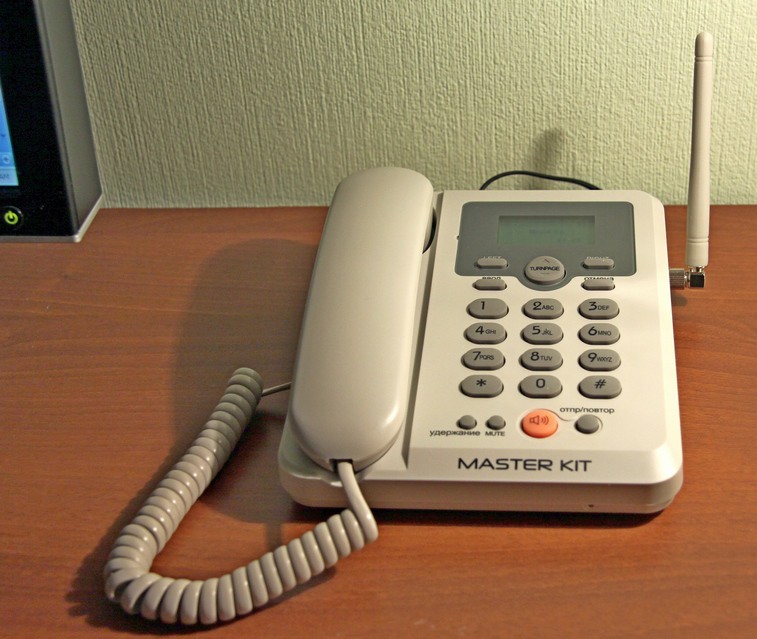
This summer I was lucky to spend a lot of time in the country, working remotely. We live in an ordinary garden partnership, and there are no blessings of civilization and high-tech, except electricity, in the house. I had to equip the workplace independently.
On the fight for a stable and fast Internet, I will soon write a separate article. And now I want to tell you about a small useful gadget that I managed to get in the process of modernizing the dacha as an office.
')
This is a landline cell phone. In general, a wired telephone is an archaic and cumbersome thing. But, first, I, for one, was very used to having an ordinary office device with a tube on the table. And, secondly, this design has some advantages over a mobile phone.
It turned out that there are quite a few such phones. I got one of the basic models - Master Kit MK303. The device itself is assembled, as is often the case, in China, but is sold under our brand.
Externally, the device differs from a regular home phone by the presence of a GSM antenna.
The antenna is quite long, which, in theory, allows for better communication. In practice, I did not notice. In addition, there is an external antenna with a wire of about 2.5 meters in case, for example, if you are in a shielded or basement room, and the signal can be caught only by the window. In very difficult cases, you can additionally buy a remote directional antenna and connect it already; there is a jack for this. This is a plus.
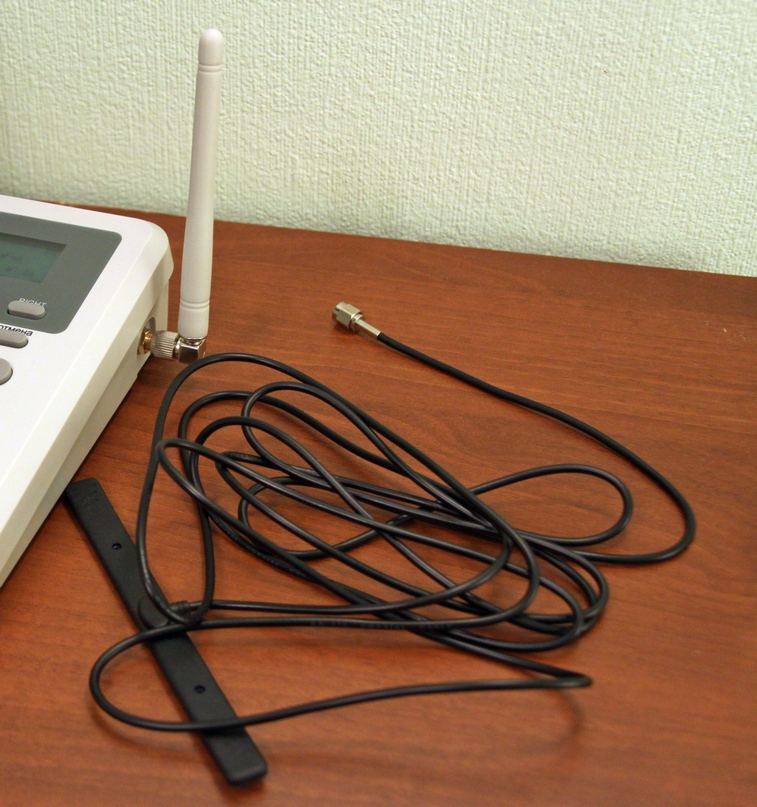
The second advantageous difference from the usual “mobile phone” is a large distance from the head to the radiating antenna (the tube does not contain any radiating elements). In conditions of poor reception of the GSM signal, the telephone transmitter usually operates at peak power (the maximum allowed is up to 2 W). With long conversations that are not rare at work, the total exposure per day is quite large. And if there is an opportunity to avoid it - I would prefer to use it.
Now, actually, about impressions.
The phone is packed in a colorful box on which its advantages are painted:

Preparation for work takes a couple of minutes: fasten the GSM antenna (internal or external), insert the battery, SIM card, connect the handset and the charger wire.

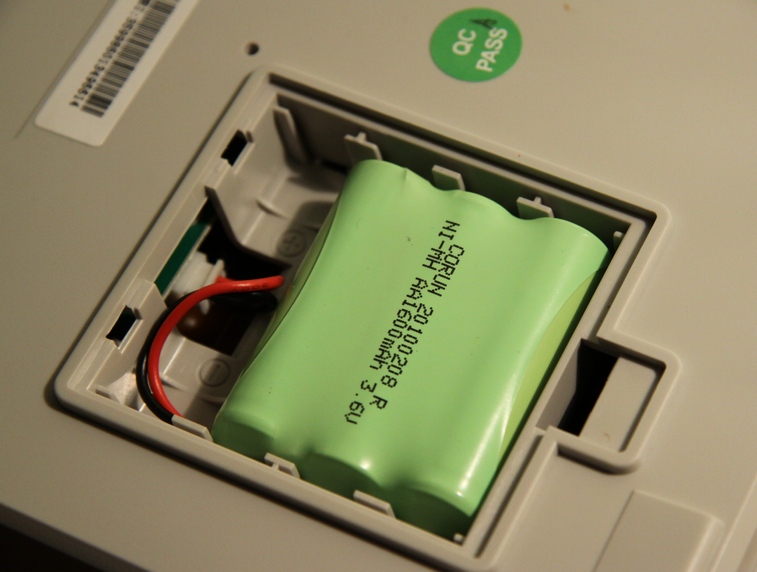
If desired, the phone can be hung on the wall:

In addition to the handset connector, there is also a power button, a power input and a service Ethernet input (not used in operation).
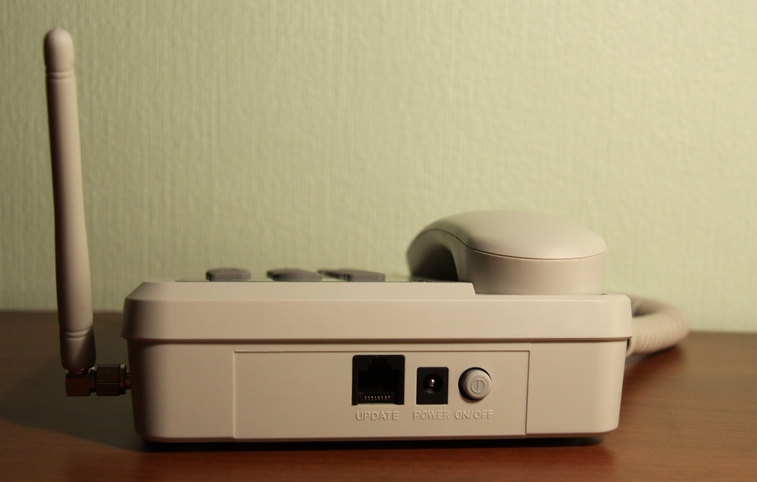

The device turns on quickly enough - 7-10 seconds to full readiness. The claimed battery life is up to 200 hours in standby mode and up to 1 hour in talk mode. I got less - about 2 days of waiting with a few minutes a day. But this may be due to a weak GSM signal in our country house (the consumed power rises), as well as an insufficiently “trained” battery - I spent only 2 discharge / charge cycles. In fact, when used indoors, the phone is likely to always work from an outlet.
The functionality of the phone includes only the most necessary: calls, SMS, address book, alarm clock (by the way, it allows you to set up to 3 alarms with flexible settings). Works in networks GSM 900/1800.
When picking up the handset, the usual “line free” beep sounds - apparently, an orientation towards the habits of older people. After dialing, the auto call is activated. The response time is adjustable. You can also call a separate button.
Screen monochrome with green backlight:
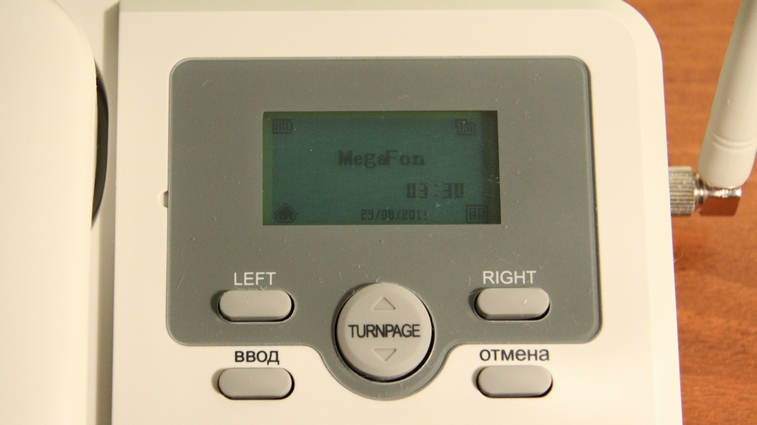

Additional buttons include speakerphone, mute, redial, call hold and menu navigation buttons.
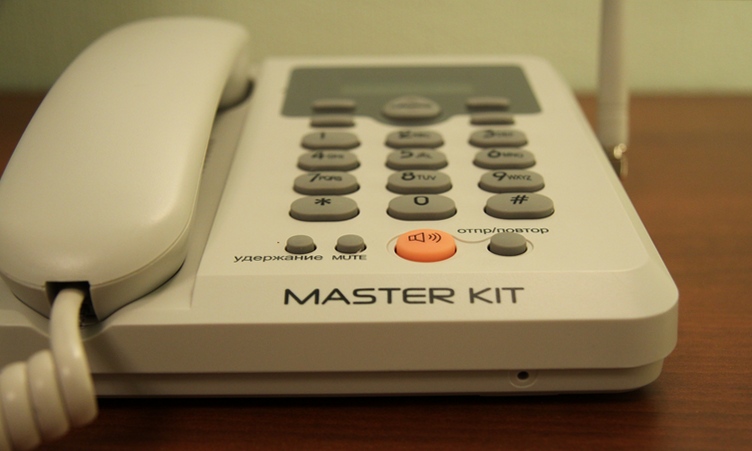
They are pressed quite tightly - a habit is required, but generally acceptable. Incidentally, I saw very few fixed phones with normal buttons.
Navigating through the menu is a little non-intuitive: the joystick is pressed up and down, and the menu is moved left-right. There are, however, separate Right-Left buttons, which creates some redundancy. I would remove these buttons on the site of the developers. I have a general feeling that only Apple can do simple interfaces.
I did not really like working with SMS. If a long message arrives, it is cut into pieces, and in order to read it completely, you have to open several SMS. It is not comfortable. However, SMS on such a phone is not more in demand than on a regular wired one, but there is still the possibility to receive them.
I had strange problems with the MTS SIM card: the network was re-initialized every few minutes with the message “MTS services. Wait". With the Megafon SIM card, which I bought specifically for this device, such problems did not arise even once.
The address book allows you to set names with a length of only 10 characters, although there is still room for about 5 on the screen. This, of course, causes certain inconveniences.
Polyphonic melodies are not supported, so I had to be content with a choice of several “tweeters”. Here, the similarity with the stationary device is rather a minus.
The positive side of operation is that the phone has flexible call forwarding settings - they are set either unconditionally, or when busy, or when no one answers.
The quality of communication is usual - it doesn’t really differ from the usual mobile phone. I tried to connect an external antenna - I did not notice the difference.
In general, I am satisfied with the phone - it performs all the necessary functions, there are no radiating elements in the handset and this phone should not be searched for. I plan now to use it in a city apartment. MGTS still does not transfer us to a digital PBX, and with this phone you can finally forget about pulse dialing.
Another useful application of the phone can be installing it, say, to elderly parents to reduce the cost of long-distance communication. Usually, people of the age are not very willing to use mobile phones. And here we get a complete imitation of a landline phone.
In Megaphone there is an interesting option “Home Zone” - with a subscription fee of 30 rubles / month, you can call landline numbers at 50 kopecks / minute. Or if you pay 350 rubles / month, calls to the city are free of charge. In some cases it is even more profitable than MGTS. The only condition is to find the phone within a radius of several tens of meters from the point selected when connecting to the service.
The price of the phone in retail varies from 3 to 3.5 thousand rubles. This is one of the most inexpensive devices in its class, which at the same time provides all the basic functions necessary for a home telephone.
The manufacturer of the phone you can find many more interesting devices .
PS For haters of heavy images to habrakat - yesterday's article on optimizing JPEG and PNG allowed to reduce the file size by 60% (up to 109 kb), so I did everything I could.
Source: https://habr.com/ru/post/127321/
All Articles